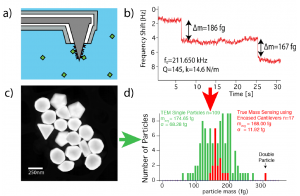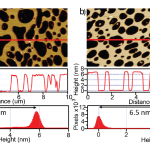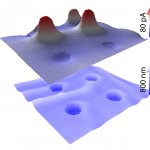Encased Cantilevers Make Quantitative Mass Sensing Simple
 Cantilever based mass sensors detect minute amounts of material and have the potential to significantly impact biological and chemical diagnostics. Added mass to the cantilever is directly measured through a resonance frequency shift, however the high damping-low Q-factor environment of liquids makes measurements of resonance frequency challenging. The low damping of encased cantilevers enables in-situ mass sensing in liquids that surpasses conventional cantilever based mass sensing, where the uncertainty of the location of the added mass, and the indirect measurement of stress induced bending require various assumptions or models to extract the exact value of the added mass. With encased cantilevers, (a) functionalization and binding of an analyte occur only at the tip and (b) a distinct shift in frequency is easily observed from two consecutive attachment events using 250 nm gold particles. The volume of the gold particles (c) shown in high-angle annular dark field electron microscopy was estimated by projected areas and assuming a spherical form factor (volume estimation in d, green histogram). True mass sensing using encased cantilevers is shown in d (red histogram), where an average mass of 168 fg/nanoparticle is measured. With the potential to reach even attogram sensitivities, encased cantilevers can be used as a sensitive mass sensor for a variety of applications in solution.
Cantilever based mass sensors detect minute amounts of material and have the potential to significantly impact biological and chemical diagnostics. Added mass to the cantilever is directly measured through a resonance frequency shift, however the high damping-low Q-factor environment of liquids makes measurements of resonance frequency challenging. The low damping of encased cantilevers enables in-situ mass sensing in liquids that surpasses conventional cantilever based mass sensing, where the uncertainty of the location of the added mass, and the indirect measurement of stress induced bending require various assumptions or models to extract the exact value of the added mass. With encased cantilevers, (a) functionalization and binding of an analyte occur only at the tip and (b) a distinct shift in frequency is easily observed from two consecutive attachment events using 250 nm gold particles. The volume of the gold particles (c) shown in high-angle annular dark field electron microscopy was estimated by projected areas and assuming a spherical form factor (volume estimation in d, green histogram). True mass sensing using encased cantilevers is shown in d (red histogram), where an average mass of 168 fg/nanoparticle is measured. With the potential to reach even attogram sensitivities, encased cantilevers can be used as a sensitive mass sensor for a variety of applications in solution.
More about this in a presentation.
To learn about additional applications, click here.


